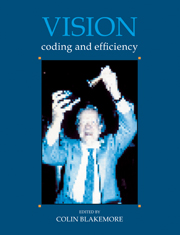Book contents
- Frontmatter
- Contents
- List of Contributors
- Preface
- Reply
- Acknowledgements
- Concepts of coding and efficiency
- Efficiency of the visual pathway
- Colour
- Brightness, adaptation and contrast
- Development of vision
- Depth and texture
- Motion
- From image to object
- 32 A theory about the functional role and synaptic mechanism of visual after-effects
- 33 Spatial and temporal summation in human vision
- 34 The efficiency of pictorial noise suppression in image processing
- 35 Algotecture of visual cortex
- 36 The iconic bottleneck and the tenuous link between early visual processing and perception
- 37 Pyramid algorithms for efficient vision
- 38 High level visual decision efficiencies
- Index
34 - The efficiency of pictorial noise suppression in image processing
Published online by Cambridge University Press: 05 May 2010
- Frontmatter
- Contents
- List of Contributors
- Preface
- Reply
- Acknowledgements
- Concepts of coding and efficiency
- Efficiency of the visual pathway
- Colour
- Brightness, adaptation and contrast
- Development of vision
- Depth and texture
- Motion
- From image to object
- 32 A theory about the functional role and synaptic mechanism of visual after-effects
- 33 Spatial and temporal summation in human vision
- 34 The efficiency of pictorial noise suppression in image processing
- 35 Algotecture of visual cortex
- 36 The iconic bottleneck and the tenuous link between early visual processing and perception
- 37 Pyramid algorithms for efficient vision
- 38 High level visual decision efficiencies
- Index
Summary
Introduction
In many electro-optical displays or photographic recordings visual detection is limited by some kind of pictorial noise. Practically all modern medical and military observation devices suffer from this problem occasionally or regularly. In this paper some psychophysical measurements will be described and discussed in order to evaluate the possible gain of noise cleaning techniques. In textbooks on image processing the justification of the various techniques usually is a matter of face-validity. Pictures are shown before and after image processing and then obviously look much better. However, there is, as far as we know, little experimental evidence of improved visual performance.
The problem of target detection in the presence of visible pictorial noise is the disentanglement of the two. Signal and noise must be separated on the basis of a priori knowledge about their differences. In this respect it is most helpful to analyse the noise into components that can be ordered according to their perceptual distance from the target. Obviously, spatial frequency analysis is attractive in this respect, both, because of its mathematical transparency and because of the present preference in the literature on visual performance. In line with this tradition visual performance is expressed in this paper in terms of contrast sensitivity for sine wave test gratings, measured as a function of spatial frequency in a number of pictorial noise conditions. Sine wave gratings may not be the most natural stimuli for the visual system, and it cannot be claimed beforehand that this angle of approach leads to a clear and complete insight into the interference of pictorial noise with the detection of arbitrary targets.
- Type
- Chapter
- Information
- VisionCoding and Efficiency, pp. 386 - 392Publisher: Cambridge University PressPrint publication year: 1991
- 1
- Cited by



